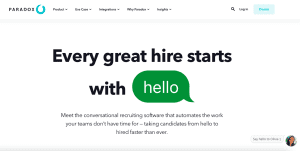
The record number of vacancies across the country is no secret. The war for talent is creating a difficult hiring environment for organizations across all industries. This has prompted a self-fulfilling prophecy, and in turn a key challenge for all businesses – the power has well and truly been put into the hands of workers (of all kinds).
The ‘great resignation’ is the result of individuals realizing they can have more control and autonomy over their careers based on their experiences during the pandemic. As a result, most have more demands from prospective employers than ever before.
Those sourcing workers with digital skills in particular are experiencing some of the starkest shortages. So, if businesses don’t look to overcome them soon and find the talent they need, they’re at significant risk of having to put their digital transformation strategies, which are crucial for their future, on hold.
Priorities are changing
A lot of digital transformation has taken place over the past 18 months, but digitizing is an ongoing process with no end game. In fact, most businesses are still playing catch up as they look to overcome the challenges created by the pandemic as many weathered the storm by adopting a reactive business continuity approach to digital development rather than taking a more strategic view on the opportunity. This is in addition to the challenges brought on by Brexit and the subsequent supply chain struggles. However, digital transformation cannot go ahead without the right people driving it.
This increased demand for a specific set of skilled workers is having a big impact on the way businesses are looking to attract them. Some have turned to increases in salary, for example, but research shows that’s not enough – employees now increasingly value flexibility on par with, if not more than, their salaries, having appreciated the work-life balance afforded to them during national lockdowns.
With so many businesses hiring from the same pool, organizations might need to think outside the box to get the people they need to drive their futures. After all, this landscape means it is becoming more time-consuming and expensive to recruit in the traditional way.
Breaking the habits of a lifetime
Especially when recruiting for digital roles, organizations are usually looking for highly specialized skills, and at short notice. Often these skills are needed for specific and individual projects, which can put HR teams under pressure to fill the gaps quickly. However, the sourcing of permanent, full-time employees typically remains the end goal, for which the traditional recruitment process is too cumbersome, expensive, and limited.
Instead, when recruiting to make up the personnel shortfall needed to deliver these projects, businesses must embrace more flexible methods beyond the standard recruitment of full-time employees. Away from the world of fixed notice periods and poor scalability, doing so can provide faster access to quality talent that businesses might not have had the pulling power to hire permanently.
For example, freelancers are playing an increasingly important role in plugging the skills gap faced by businesses. It’s becoming a more attractive career option for many, as individuals realize they can take back control of their own time and prospects. Many furloughed workers who have turned to self-employment simply haven’t gone back. Thankfully, embracing this more flexible talent pool is an important and efficient way of making the recruitment function – and therefore the company’s workflows – more agile.
Businesses should remember that embracing a more flexible and elastic workforce must be matched by a more flexible way of working. To truly take advantage of the sharing economy for skilled labor, they must have a global mindset, rather than falling into the trap of settling for local candidates, something now possible with most knowledge workers based remotely. After all, the benefits of a flexible and elastic workforce will be largely redundant if the search for said skilled workers is restricted to a comfortable commuting distance.
It’s time for change
It’s hard to believe that so many businesses are putting potentially revenue-generating projects on hold because of hiring struggles. The incumbent recruitment strategy feels even more outdated when you consider that many of the skills they need today might be different tomorrow. However, working with skilled freelancers – or building an elastic team– to complement full-time staff, means businesses can use as much or as little resource as they like and scale and recompose depending on demand.
This doesn’t put recruiters out of a job. Like all industries, it simply demonstrates a need to evolve. As we look to 2022, businesses will need to adopt more flexible approaches to recruitment and talent management. This doesn’t mean simply putting better ‘perks’ in a place like hybrid working – arguably the bare minimum for today’s workforce – but shifting to a new flexible, elastic model that can respond to how the hiring and recruitment landscape is changing.
By Callum Adamson, Co-Founder & CEO, Distributed.




